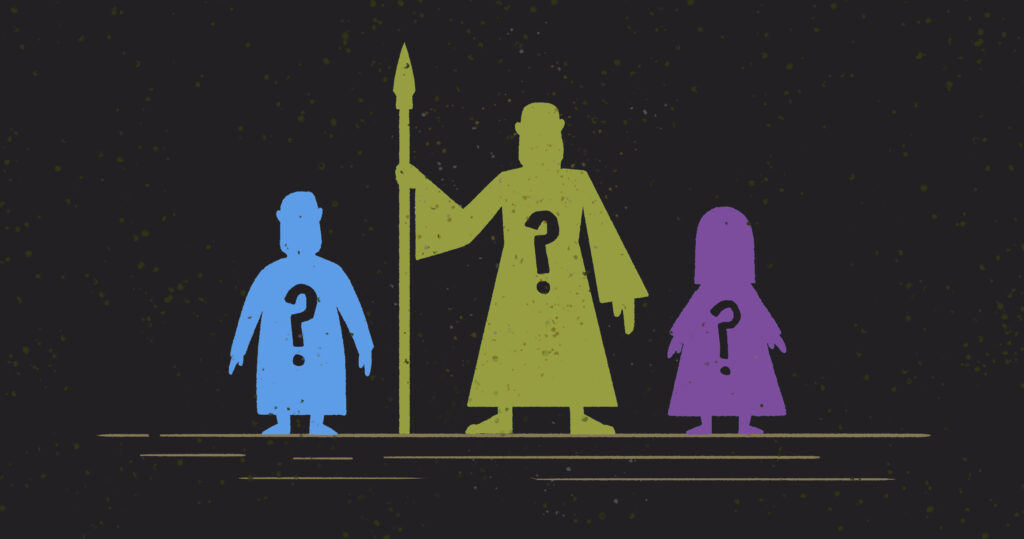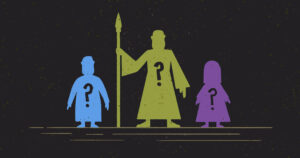Who Had been the Nephilim and the Sons of God and Daughters of Man? (Genesis 6)

This text is a part of the Robust Passages collection.
Take heed to the Passage
Learn the Passage
1When man started to multiply on the face of the land and daughters had been born to them, 2 the sons of God noticed that the daughters of man had been engaging. And so they took as their wives any they selected. 3Then the Lord stated, “My Spirit shall not abide in man endlessly, for he’s flesh: his days shall be 120 years.” 4The Nephilim had been on the earth in these days, and in addition afterward, when the sons of God got here in to the daughters of man and so they bore kids to them. These had been the mighty males who had been of outdated, the boys of renown.
—Genesis 6:1–4
Three Mysterious Teams of Individuals
The timing of this episode is launched in slightly imprecise phrases: “When man started to multiply on the face of the land and daughters had been born to them” (Gen. 6:1). Nevertheless, from what follows it seems that these occasions happen through the lifetime of Noah. Right now “the sons of God noticed that the daughters of man had been engaging [Hb. “good”]. And so they took as their wives any they selected” (Gen. 6:2). The language of seeing and taking one thing perceived to be good echoes the primary temptation in Genesis 3:6, so it’s clear that this motion represents a major sin on the a part of the “sons of God.” However who’re the “sons of God” and the “daughters of man,” and why is their intermarriage sinful?
Three views of the identification of those teams have been argued, with the primary two explanations each discovering help for the reason that earliest interpreters.1 The primary view means that the “sons of God” are the descendants of the road of Seth, with the “daughters of man” being the descendants of Cain.2 The second view interprets the “sons of God” as (demonic) spirit beings, who interact in sexual activity with human ladies (“daughters of man”). Justin Martyr (AD 100–160) wrote, “God, when He had made the entire world, and subjected issues earthly to man, . . . dedicated the care of males and of all issues below heaven to angels whom He appointed over them. However the angels transgressed this appointment, and had been captivated by love of girls, and begat kids who’re these which can be referred to as demons.”3 In the meantime, a 3rd view identifies the “sons of God” as kings, who in lots of historic Close to Jap societies claimed divine standing for themselves as “sons of the gods.” These kings had the facility of life and dying over their topics, and on this interpretation the stress in Genesis 6:2 lies on the rulers’ taking over “any [of the daughters of men] they selected.” These kings seize no matter ladies they need for his or her harems—marrying not only one lady, as God meant (Gen. 2:24), however as many as they select. Whereas Lamech first broke God’s sample for marriage by having two wives (Gen. 4:19), these kings multiply that sin many occasions over by multiplying for themselves wives.4
4 biblical students supply passage-by-passage commentary by means of the narratives of Genesis, Exodus, Leviticus, and Numbers, explaining troublesome doctrines, shedding mild on neglected sections, and making purposes to life and ministry right now. A part of the ESV Expository Commentary.
Every of those views has ready exponents and is defensible, although every has its personal issues. The best problem for the primary view is that nowhere else within the OT are human beings described because the “sons of God”; quite the opposite, the time period persistently designates angelic beings (cf. Job 1:6; 38:7; and possibly Deut. 32:8).5 As well as, “daughters of man” in Genesis 6:2 appears clearly associated to the daughters born to males in Genesis 6:1, which doesn’t appear to restrict them to a selected subgroup (i.e., the daughters of the road of Cain).6 Furthermore, some NT passages appear to reference the involvement of non secular beings in these occasions. For instance, Jude 6–7 speaks of angels’ leaving their correct house and sinning in a approach much like the sin of Sodom and Gomorrah in pursuing “unusual flesh.”7 Equally, 1 Peter 3:19–20 references the proclamation of the gospel to spirits who had been disobedient within the time of Noah.
The principle problem for the second view is the query of whether or not angels are able to producing offspring by means of intercourse with people (cf. Matt. 22:30). John Calvin says the angelic view “is abundantly refuted by its personal absurdity; and it’s shocking that realized males ought to previously have been fascinated by ravings so gross and prodigious,”8 although it should be stated that historic audiences didn’t discover the thought as clearly absurd as Calvin did. Furthermore, Genesis says remarkably little in regards to the world of angelic beings, good or dangerous; quite the opposite, it’s targeted rather more intently on human sin and its penalties.9 Certainly, the transgression in Genesis 6 (no matter it could be) appears to lead to a particular judgment that comes upon humanity, not on angelic beings.
The third view affords a possible rationalization for using the language of “sons of God” to explain people however doesn’t essentially present a a lot better different general. Typically, historic Close to Jap kings as people could have styled themselves as “son of the gods,” however there’s little proof for using “sons of the gods” as a collective time period for kings or rulers. There appears little curiosity within the political group of the traditional city-states in Genesis 4, which references farming, music, and know-how as advances belonging to the road of Cain however says nothing in any respect explicitly about kingship.
It’s onerous to ascertain with any certainty which of those interpretations is to be most popular. Nevertheless, a major contextual consideration is the truth that the distinction between the traces of Cain and of Seth kinds the bigger backdrop in opposition to which this episode happens. Certainly, Genesis 6:1–8 is itself included into the bigger family tree of Seth that begins in chapter 5 and concludes in 9:29.10 On this view the passage supplies an evidence of why the 2 households don’t lead to massive numbers of individuals within the class of “righteous” and “depraved.” As a result of so lots of the sons of the road of Seth intermarry indiscriminately, the result’s an virtually full lack of the righteous line.
What’s extra, it’s also true that, although the OT doesn’t elsewhere use “sons of God” to explain God’s individuals, the thought just isn’t completely international to the passage. In Genesis 5:1–3 picture and sonship are intimately related: Adam is made in God’s picture, and he passes that picture on to his kids by means of Seth. If Adam is thus, by advantage of bearing his picture, God’s son (Luke 3:38), and Seth is explicitly made within the picture of Adam (Gen. 5:3), couldn’t Seth and his line rightly be referred to as “sons of God”?11
Lastly, elsewhere within the Bible Devil’s three major modes of assault on God’s individuals take the type of deception, persecution, and seduction,12 and it might be argued that the identical modus operandi is clear already within the opening chapters of Genesis: deceiving Eve (Genesis 3), martyring Abel (ch. 4), and now seducing the road of promise (6:1–4). These concerns, taken collectively, persuade me that the interpretation that understands the sin as being the wrongful mixing of the traces of Seth and the road of Cain is right, although the choice views every has its strengths.
Whichever interpretation is adopted, what’s abundantly clear is that as man multiplies and fills the earth—proof itself of God’s blessing (Gen. 1:28)—sin multiplies additionally. The sin of those verses kinds an evil parody of the creation mandate: these beings, who aspire to be within the picture of God, search to fill the earth with their offspring as God has commanded, however they go about it within the flawed approach, abusing the wedding relationship to serve their corrupt wishes and in search of to make a reputation for themselves, following the sample of Cain (6:4; cf. 4:17).
On this pursuit they’re unsuccessful, as is the case for each act of human rise up in Genesis. God judges the “sons of God,” and their sin leads to curse and destruction slightly than the blessing and prosperity that was sought. Simply as indiscriminate consuming in Genesis 3 resulted in dying, so too indiscriminate marriage that transgresses the boundaries set by God leads to dying. In distinction to the prolonged lives of the antediluvian patriarchs in Genesis 5, human life can be restricted to a mere 120 years.13 The explanation given (“For he’s flesh”; 6:3) may describe human mortality or corruption. The truth is, each are possible in view: human mortality is the results of human corruption, and the growth in corruption in these verses can be matched by a lower in human lifespan. The divine breath/ spirit provides life to humanity, and, when it’s withdrawn, the result’s dying (cf. Gen. 2:7; Pss. 104:29; 146:4; Ezek. 37:10).

We All Want Reminders!
Within the busyness of life it’s all too simple to neglect who God is, what he has executed for us, and who we’re due to him. Crossway desires to assist! Join right now to obtain concise Scripture-filled, gospel-saturated reminders that may encourage you and strengthen your stroll with Jesus.
The judgment of Genesis 6:3 logically separates verses 1–2 from verses 4–5, although they’re linked by the renewed point out of the sons of God and the daughters of man in verse 4. The result’s a chiastic construction that focuses our consideration on the judgment curse that falls on humanity:
(A) Humanity multiplies on the face of the earth (Gen. 6:1)
(B) Sin will increase: the sons of God and daughters of males transgress (Gen. 6:2)
(C) Judgment declared upon humanity (Gen. 6:3)
(B’) Sin will increase: the Nephilim and mighty males transgress (Gen. 6:4)
(A’) Human wickedness grows nice within the earth (Gen. 6:5)
The importance of this statement is to notice that the sin in verse 4, whereas contemporaneous with that of verse 2 (“When the sons of God got here in to the daughters of man and so they bore kids to them”),14 just isn’t essentially an identical to it. In different phrases, the Nephilim and the mighty males usually are not essentially the offspring of the sons of God and daughters of males, as is usually assumed by the interpretation that sees the sons of God as angelic beings.15Genesis 6:4 merely asserts that the Nephilim (“fallen ones,” cf. CSB mg.) had been additionally current throughout these corrupt days, in addition to afterward. It doesn’t inform us something in regards to the Nephilim, assuming that readers are already conversant in these individuals.
The one different express reference within the Bible to the Nephilim is at Numbers 13:33, the place the scouts declare that the fearsomely massive Anakim that they encountered had been “of” (min) the Nephilim. This Hebrew development may imply that the Anakim had been “descended from” the Nephilim, although that raises questions on how the Nephilim may have survived the flood.16 Extra possible the purpose of the comparability is that the Anakites shared the traits of the Nephilim of outdated, not that they had been really associated to them. In that case, Numbers 13 provides us a window into what the unique viewers of Genesis thought the Nephilim had been like: tall and robust, fearsome and invincible in battle.
Given this, it is smart to establish the Nephilim because the antecedent of the pronoun within the final a part of Genesis 6:4: “they” would then seek advice from the Nephilim slightly than to the youngsters of the illicit unions described instantly earlier than, in order that the Nephilim could be the “mighty males” (“warriors”; gibborim) and the “males of renown” (or “males of identify”). In that capability the Nephilim characterize a distinct manifestation of the expansion of sin, particularly, self-promoting violence slightly than sexuality. Their sin lies in in search of to make a reputation for themselves by means of their army conquests slightly than humbly calling on the identify of the Lord, as the road of Seth had executed (cf. 4:26). Not coincidentally, Lamech celebrated his deviancy in each his sexuality and his fame-seeking violence in 4:19–24; likewise the common unfold of sin in Genesis 6 demonstrated in each these areas. But, because the concentric construction emphasizes, what counts in the end just isn’t human striving however God’s motion, right here in judgment (and later in making a reputation for his chosen one, Abraham; cf. 12:2).
Notes:
- On the early interpretation of this passage cf. Robert C. Newman, “The Historic Exegesis of Genesis 6:2, 4,” Grace Theological Journal 5 (1984): 13–36.
- This view is held by, amongst others, Augustine, Metropolis of God, 15.22–23; John Calvin, Genesis (1554; repr., Edinburgh: Banner of Reality Belief, 1992), 1.238; Robert S. Candlish, Research in Genesis (repr., Grand Rapids, MI: Kregel, 1979), 123–124; Mathews, Genesis 1–11:26, 324–331.
- Justin Martyr, Apology 2.5 (cited in Newman, “Historic Exegesis of Genesis 6:2, 4,” 21–22).
- For this view cf. Meredith G. Kline, “Divine Kingship and Genesis 6:1–4,” WTJ 24 (1962): 187–204; so additionally Waltke, Genesis, 116–117.
- Deuteronomy 32:8 has text-critical difficulties, however the studying “sons of God” slightly than “sons of Israel” appears possible. Cf. Michael S. Heiser, “Deuteronomy 32:8 and the Sons of God,” BSac 158 (2001): 52–74.
- It’s potential to adapt the primary view to take “daughters of males” globally as protecting all ladies, not simply the daughters of the road of Cain. On this understanding the sons of Seth weren’t intentionally marrying outdoors the road of promise however had been carelessly marrying whichever ladies they selected, irrespective of their origins. Cf. Mathews, Genesis 1–11:26, 330.
- It’s price noting that Jude additionally cites elsewhere from 1 Enoch, which clearly adopts the supernatural being view; cf. Newman, “Historic Exegesis of Genesis 6:2, 4,” 16, 28–29.
- Calvin, Genesis, 1.238.
- Cf. Vos, Biblical Theology, 48.
- Cf. Mathews, Genesis 1–11:26, 329.
- It’s hanging that in Genesis 5 it’s explicitly Seth who bears Adam’s picture, not Cain. Furthermore, all the opposite makes use of of bene-ʾelohim happen outdoors the Pentateuch (with the potential exception of Deuteronomy 32:8).
- Deception (2 Cor. 11:14; Rev. 12:9); persecution (1 Pet. 5:8; Rev. 2:10); seduction (2 Cor. 11:2–3; Rev. 19:2).
- On the interpretation problems with Genesis 6:3 cf. Mathews, Genesis 1–11:26, 332–335. That is clearly not an absolute limitation of age, since Abraham lives to be 175 (Gen. 25:7), however after this level only a few individuals exceed that quantity.
- We could word the similarity to the temporal clause in Genesis 6:1 (“When man started to multiply on the face of the land and daughters had been born to them”) as supporting the interpretation of this phrase in Genesis 6:4 as temporal slightly than causal.
- A connection that’s possible behind the LXX translation, gigantes (“giants”), which was then adopted by the KJV.
- The Talmud suggests the unlikely chance that certainly one of them clung to the surface of the ark!
This text is by Iain M. Duguid and is tailored from ESV Expository Commentary: Genesis–Numbers (Quantity 1) edited by Iain M. Duguid, James M. Hamilton Jr., Jay Sklar.
Widespread Articles in This Sequence








